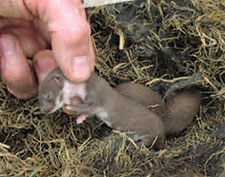A Secretive Species Found on the Farm

least weasels (Mustela nivalis)
May is one of my favorite months. So much in nature is awakening and engaging in the growing season, so time outside on one evening in May turned out to be a treat for me. On this day, the spring clouds were dark and the wind was strong. I knew that if I did not cover the garden soil I had just prepared, it would make planting the vegetable seeds impossible. I had to find something to cover the soil from the rain.
It occurred to me that the long piece of sheet-metal lying on the ground in the sheep pasture that was once used to cover the chick pen would do the trick. I recalled the numerous times that I had picked up the metal to see what might be hiding under it.
Occasionally there would be a black racer snake, or eastern garter snake, and often there were meadow voles. Those little brown, chubby, short-tailed voles had runways under the sheet and also built small domed nests out of dry grass. I wondered if I might see anything hiding under there this time.
Within the fraction of a second, lifting the sheet metal, I saw a small streaking jet of fur dashing to my right. I found myself instinctively trying to stop it by trapping it under my foot. I missed by a long shot and with surprise I yelped, “Whoa, a short-tailed weasel!” I have never seen one alive.
Yet even in that split second I was convinced that this bulleting apparition was indeed that tiny species. I put the metal back down into the tall grass, wondering if the weasel was living there. I noticed one of the voles’ nests was still in place there, but I also saw that there was a dead vole lying next to it. I was perplexed.
The next day I checked under the sheet metal to see if I might find the short-tailed weasel again. I crouched way down to peek under the metal — no weasel. But strangely, there was a second dead vole lying next to the nest. I took a closer look at the voles’ grass nest and noticed it was also composed of fur. I poked apart the nest with my finger to check on the contents. I was surprised to find four young weasels inside the nest. They were young enough that their eyes were still closed.
The least weasel (Mustela nivalis) it not a rare mammal, but it is so small, secretive and fast it is rarely seen. At seven to eight inches, it is the smallest carnivore in the world. It is a member of the meat-eating mammal order (Carnivora) which includes cats, dogs, bears, seals, etc. The least weasel is only slightly larger than the meadow voles it was eating in the pasture, but is so aggressive that it will also eat prey much larger than itself.
I only bothered the family one more time a week later. The young had opened their eyes and were moving about in the vole tunnels. Once again this experience reminded me to expect the unexpected when surrounded by the amazing world of Mother Nature.
Charles Bier is the senior conservation scientist for the Western Pennsylvania Conservancy.
To hear an audio version of Charles Bier’s Field Notes visit iTunes to download free podcasts of his personal accounts and observations of Western Pennsylvania’s natural environment.
